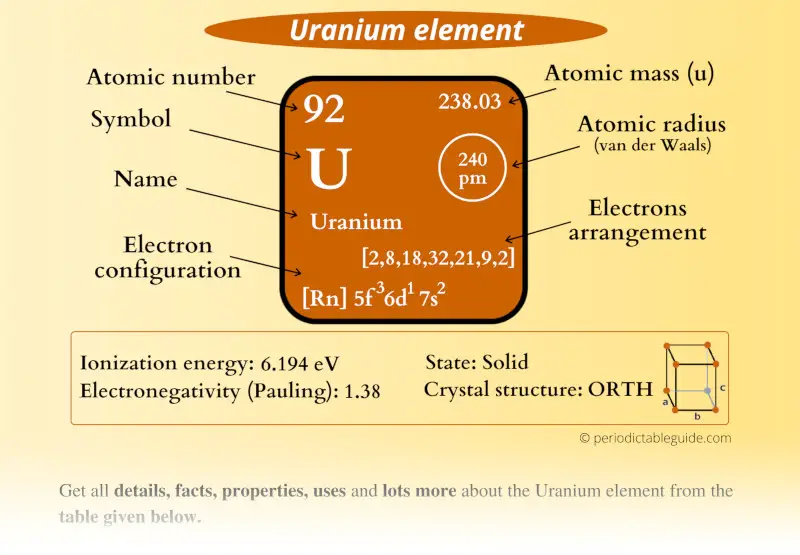
This is a SUPER easy guide on Uranium element.
In fact, the table mentioned below is the perfect information box (Which gives you every single detail about the Uranium element in Periodic table.)
So if you want to know anything about Uranium element, then this guide is for you.
Let’s dive right into it!
Uranium Element (U) Information
| Appearance | 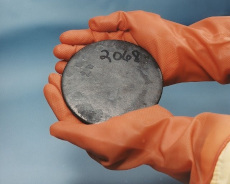 Silvery-gray metallic surface |
| State (at STP) | Solid |
| Position in Periodic table | 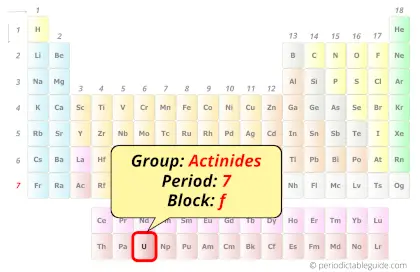 Group: actinides, Period: 7, Block: f |
| Category | 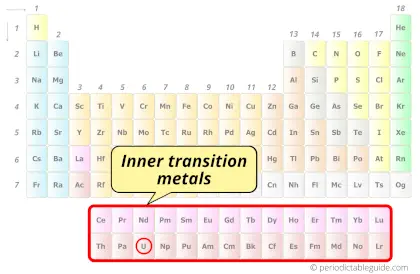 Inner transition metals |
| Atomic number or Protons | 92 |
| Neutrons | 146 |
| Electrons | 92 |
| Symbol | U |
| Atomic mass | 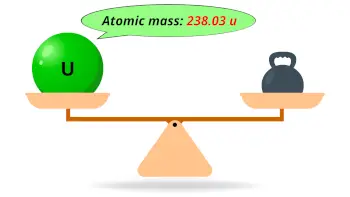 238.03 u |
| Electrons arrangement or Bohr model | 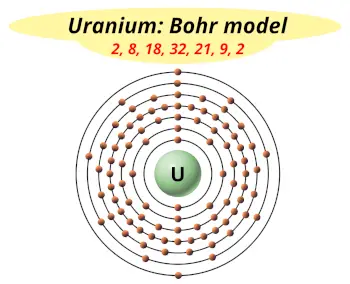 2, 8, 18, 32, 21, 9, 2 |
| Electronic configuration | [Rn] 5f3 6d1 7s2 |
| Atomic radius | 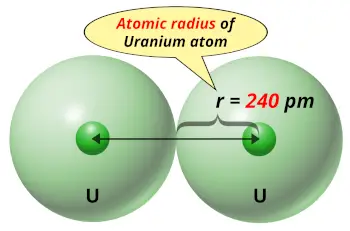 240 picometers (van der Waals radius) |
| 1st Ionization energy | 6.194 eV |
| Electronegativity | 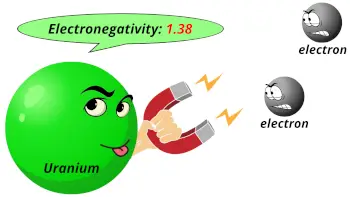 1.38 (Pauling scale) |
| Crystal structure | 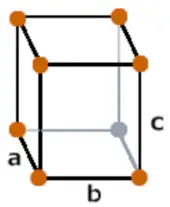 Orthorhombic |
| Melting point | 1405 K or 1132 °C or 2070 °F |
| Boiling point | 4404 K or 4131 °C or 7468 °F |
| Density | 19.05 g/cm3 |
| Main isotopes | 234U, 235U and 238U |
| Who discovered Uranium and when? | 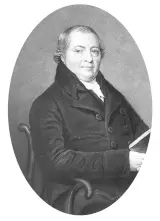 Martin Heinrich Klaproth (in 1789) |
| CAS number | 7440-61-1 |
Uranium in Periodic table
Uranium element is in period 7 and in actinides group of the Periodic table. Uranium is the f-block element and it belongs to inner transition metals group.
| H | He | ||||||||||||||||
| Li | Be | B | C | N | O | F | Ne | ||||||||||
| Na | Mg | Al | Si | P | S | Cl | Ar | ||||||||||
| K | Ca | Sc | Ti | V | Cr | Mn | Fe | Co | Ni | Cu | Zn | Ga | Ge | As | Se | Br | Kr |
| Rb | Sr | Y | Zr | Nb | Mo | Tc | Ru | Rh | Pd | Ag | Cd | In | Sn | Sb | Te | I | Xe |
| Cs | Ba | La* | Hf | Ta | W | Re | Os | Ir | Pt | Au | Hg | Tl | Pb | Bi | Po | At | Rn |
| Fr | Ra | Ac** | Rf | Db | Sg | Bh | Hs | Mt | Ds | Rg | Cn | Nh | Fl | Mc | Lv | Ts | Og |
| *Ce | Pr | Nd | Pm | Sm | Eu | Gd | Tb | Dy | Ho | Er | Tm | Yb | Lu | ||||
| **Th | Pa | U | Np | Pu | Am | Cm | Bk | Cf | Es | Fm | Md | No | Lr |
←Move to: Protactinium (Pa) element – Periodic Table
→Move to: Neptunium (Np) element – Periodic Table
Why is Uranium in Period 7?
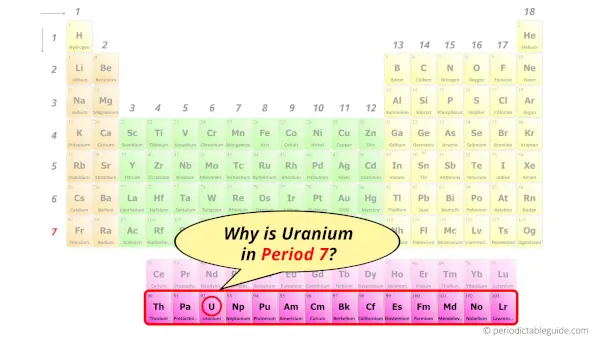
Let me ask you a question.
How many shells does uranium have?
It’s 7. Right?
You have already seen the bohr model of uranium atom in the above table.
From the Bohr model, it can be found that the number of orbits or shells in uranium is 7. Hence, as uranium has 7 orbits, it lies in period 7 of the Periodic table.
Why is Uranium in f-block?
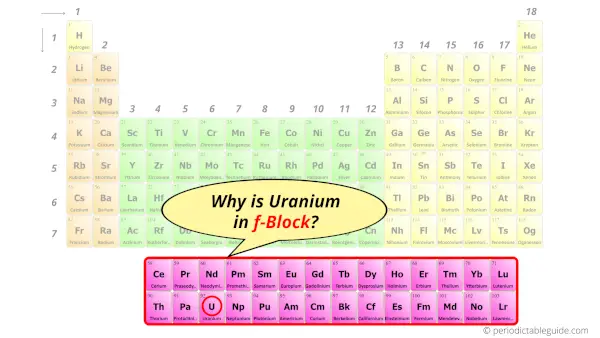
Before knowing this reason, first of all I want to ask you a simple question.
How can you determine the blocks-wise position of elements?
The simple answer: The elements will lie in the s, p, d or f block will completely depend upon the subshell in which the last electron will enter.
For example; the electron configuration of uranium is [Rn] 5f3 6d1 7s2.
Here, the last electron of uranium enters the f-subshell or f-orbital.
Hence, uranium is the f-block element.
5 Interesting facts about Uranium
Interesting facts about uranium element are mentioned below.
- The name “Uranium” was derived from the name of the planet “Uranus”, which was itself named after the Greek god of sky Uranus.
- The first atomic bomb which was used in World War II (Hiroshima, Japan) was made from Uranium.
- Uranium was discovered by Martin Heinrich Klaproth in 1789.
- Uranium is mostly obtained from the earth’s crust from its mineral ore uraninite.
- Uranium is the 50th most abundant element from the earth’s crust and it is mined from countries like Kazakhstan, Canada, Australia, Niger, Namibia and Russia.
Properties of Uranium
The physical and chemical properties of uranium element are mentioned below.
Physical properties of Uranium
Physical properties of uranium are mentioned below.
- The pure uranium metal is solid and has a silvery-grey metallic surface.
- Uranium has many isotopes, and all those isotopes are radioactive in nature.
- The melting point of pure uranium is 1132 °C and its boiling point is 4131 °C.
- Uranium has an Orthorhombic crystal structure.
- The atomic mass of uranium is 238.03 u and its density is 19.05 g/cm3.
Chemical properties of Uranium
Chemical properties of uranium are mentioned below.
- When uranium is allowed to come in contact with the atmospheric air, it forms an oxide layer on it.
- Uranium is generally not affected by alkalis but it dissolves in the acids.
- Apart from being radioactive, it is also highly toxic.
Uses of Uranium
The uses of uranium are mentioned below.
- The uranium is used mainly as a nuclear fuel in nuclear power plants to generate electricity.
- The heat present in the earth’ crust is also due to the presence of uranium and thorium element.
- Before its radioactivity was discovered, it was used in making yellow glass as well as pottery glazes.
- Apart from these, it is also used for research work in chemistry.
Explore our New Interactive Periodic Table (with Rotating Bohr Models and More)
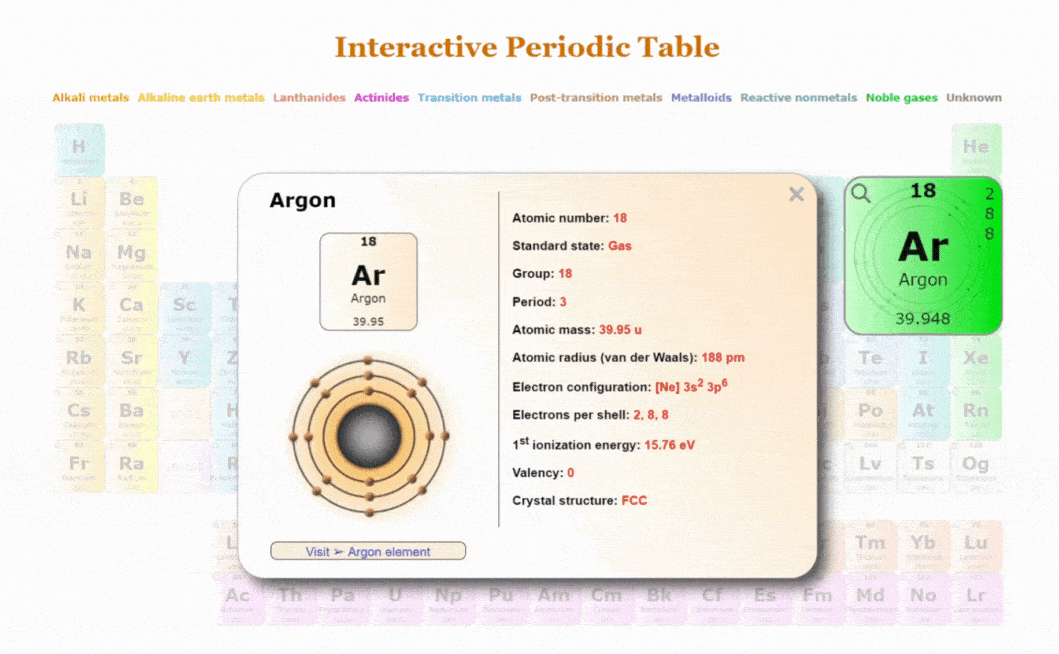
Details about this Periodic table:
- Access detailed info on all elements: atomic mass, electron configurations, charges, and more.
- View rotating Bohr models for all 118 elements.
- Get a free HD image of the Periodic Table.
Note: For future use, bookmark this Periodic table or visit “PeriodicTableGuide.com”
External resources:
- Uranium – Element information, properties and uses | Periodic Table. (n.d.). Uranium – Element Information, Properties and Uses | Periodic Table. https://www.rsc.org/periodic-table/element/92/uranium
- Uranium – Wikipedia. (2014, August 6). Uranium – Wikipedia. https://en.wikipedia.org/wiki/Uranium
- Nuclear Fuel Facts: Uranium. (n.d.). Energy.gov. https://www.energy.gov/ne/nuclear-fuel-facts-uranium
- P. (n.d.). Uranium | U (Element) – PubChem. Uranium | U (Element) – PubChem. https://pubchem.ncbi.nlm.nih.gov/element/Uranium
- It’s Elemental – The Element Uranium. (n.d.). It’s Elemental – the Element Uranium. https://education.jlab.org/itselemental/ele092.html
- What is Uranium? How Does it Work – World Nuclear Association. (n.d.). What Is Uranium? How Does It Work – World Nuclear Association. https://world-nuclear.org/information-library/nuclear-fuel-cycle/introduction/what-is-uranium-how-does-it-work.aspx
- Uranium. (n.d.). NRC Web. https://www.nrc.gov/reading-rm/basic-ref/glossary/uranium.html
- Manhattan Project: Science > Nuclear Physics > URANIUM CHEMISTRY AND METALLURGY. (n.d.). Manhattan Project: Science > Nuclear Physics > URANIUM CHEMISTRY AND METALLURGY. https://www.osti.gov/opennet/manhattan-project-history/Science/NuclearPhysics/uranium-chemistry.html
